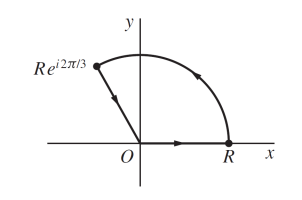fraction with numbers is different than fraction with letters. that's what i learn in algebra. look at \(\displaystyle x\), it's variable not number
My point was if you write the fraction as [imath]\displaystyle \frac{1}{6}[/imath] when it is meant to be [imath]\displaystyle \frac{5}{6}[/imath], you are missing some terms in the numerator. These terms are not difficult to find when you are calculating simple fractions as [imath]\displaystyle \frac{1}{2} + \frac{1}{3}[/imath]. But when the fractions are polynomials, you will need to do some work to find the missing terms as was explained to you in post #18 by fresh_42.
As professor Dave has told you, it is good to know how to solve by partial fraction, but in this problem you have to put this method aside as you were told not to use it. If I were you, I would directly solve the problem by complex analysis.
Thank you for uploading this picture. It helps a lot to understand what to calculate. In the contour, you have three paths, so you will need to solve three integrals:
[imath]\displaystyle \int_{C_1} f(z) \ dz + \int_{C_2} f(z) \ dz + \int_{C_3} f(z) \ dz = 2\pi iB[/imath]
If you have solved contours before, you would already know that the curve path would get cancelled as it would be equal to zero. Therefore, two paths would remain:
[imath]\displaystyle \int_{C_1} f(z) \ dz + \int_{C_3} f(z) \ dz = 2\pi iB[/imath]
Your first task is to find [imath]\displaystyle B[/imath] which is the residues at the zeros that are located inside the contour. To find [imath]\displaystyle B[/imath], you need first to find the zeros which is the easiest part in the problem.
[imath]\displaystyle x^3 + 1 = 0[/imath] (Since this is a cubic function, you should get three zeros. Some are imaginary.)
I remember that there is a post written by fresh_42 where he showed the method of finding all the roots (real and complex) of a function. You can use it as a quick guidance. If you got stuck in finding the complex roots, use W|A.
Note: It is not difficult to show that the integral of the curve path will be zero as [imath]\displaystyle R \rightarrow \infty.[/imath]



